Free shipping orders over $50
Best Walkers for Seniors: A Guide to Adult Walkers
Adult walkers are solid frames of metal tubing with four legs and optional front wheels that provide a wide area of support for patients with significant balance or mobility issues.

Compared to other walking aid types, medical walkers require the least coordination for safe usage, making them ideal for users who have enough physical strength to walk and don't need to be in a wheelchair, but require a high level of support to do so. To ensure user safety, mobility walker users should have enough hand function to push the framework while walking.

“Zimmer frames” is a common British English term for medical walkers and is derived from the walker brand Zimmer.
Using a Walker
Walkers are designed for independent walkers who require balance support on both sides of their body.
An indication that it may be time for a walker is if the potential user finds that they are holding onto walls or furniture for support while walking, or if they have been using a rollator and find that it does not provide sufficient balance support.
| Pros | Cons |
|---|---|
| Provides stability | Requires use of both arms |
| Wide base of support and less wheels reduces risk of falls | Use requires leaning forward, which may affect posture |
| Foldable and portable | Slows walking (requires lifting and setting down with each step) |
Walkers vs. Rollators
Of all the walking aid types, walkers and rollators are the two most similar products. However, when choosing between the two, there are very significant differences that set them apart. The main differences to consider are the wheels and seat.
While rollators have four wheels, walkers have either two or no wheels, making them sturdier and safer for individuals with less balance. On the flip side, they do not have the convenience of a seat, like rollators do, to provide a place to rest while the user is on the go.
Other notable differences include the more medical look of walkers compared to rollators, and the significantly lower product weight of walkers.
Walker Types
There are many types of walkers available to address different mobility needs. The following are some of the main medical walker variations you may want to consider.
Folding Walkers
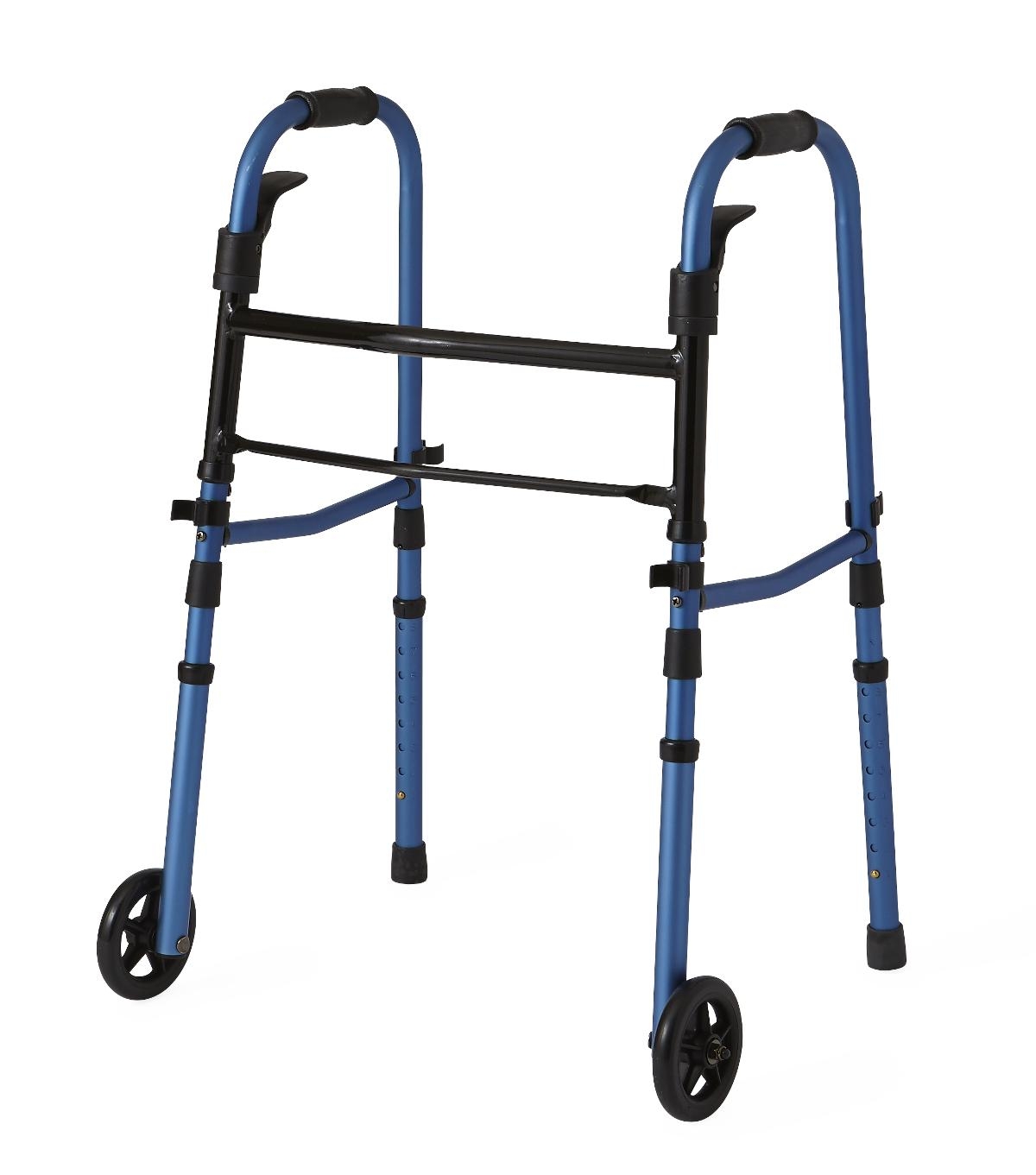
Most standard medical walkers have some kind of mechanism to allow the walker to be folded. The ability to fold a walker means easier storage and transport and, in the case of a two-button folding walker, continuous support even while navigating through narrow spaces.
Non-Folding Walkers
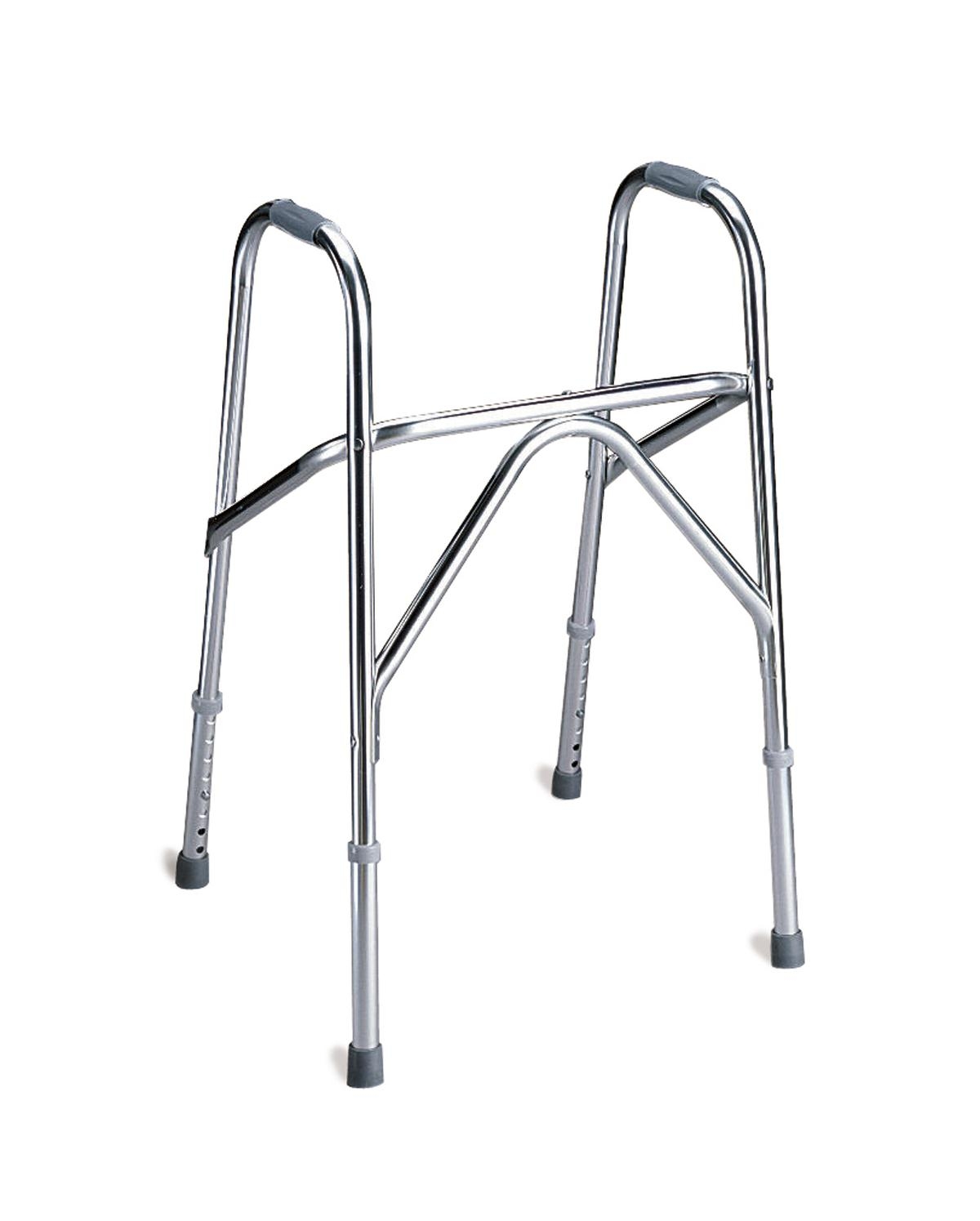
Despite the obvious benefits of folding walkers, users who need maximum assistance with balance are generally better off with a non-folding walker, which has a rigid frame that eliminates even the slightest wobble.
Bariatric Walkers
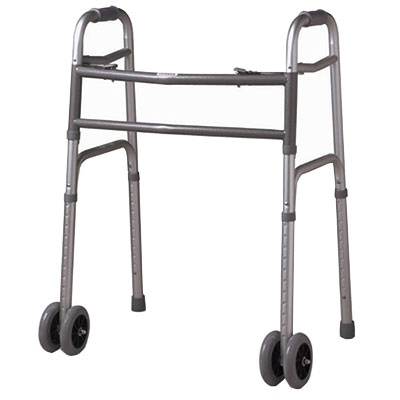
Heavy duty walkers, also known as bariatric walkers, are walkers built with larger users in mind. Their extra wide frame sizes provide a better fit while the higher weight capacity ensures safe support for users.
Stand Assist Walkers
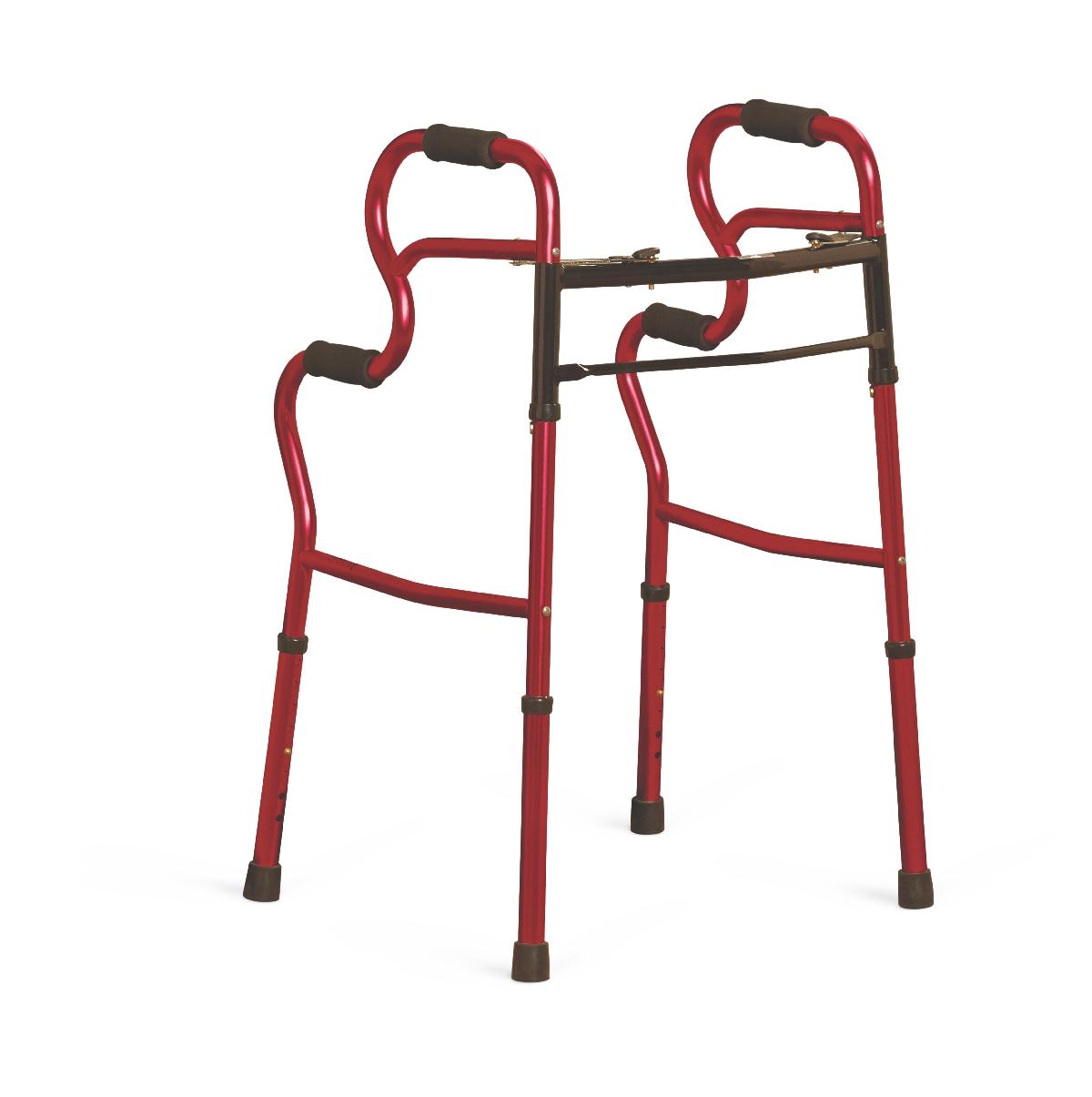
A stand assist walker is a three-in-one walker that offers the additional functions of a rising aid and a portable toilet safety frame. The bi-level handles on this walker help patients ease into a standing position and can also be used for safety and support while using the bathroom.
Pediatric Walkers
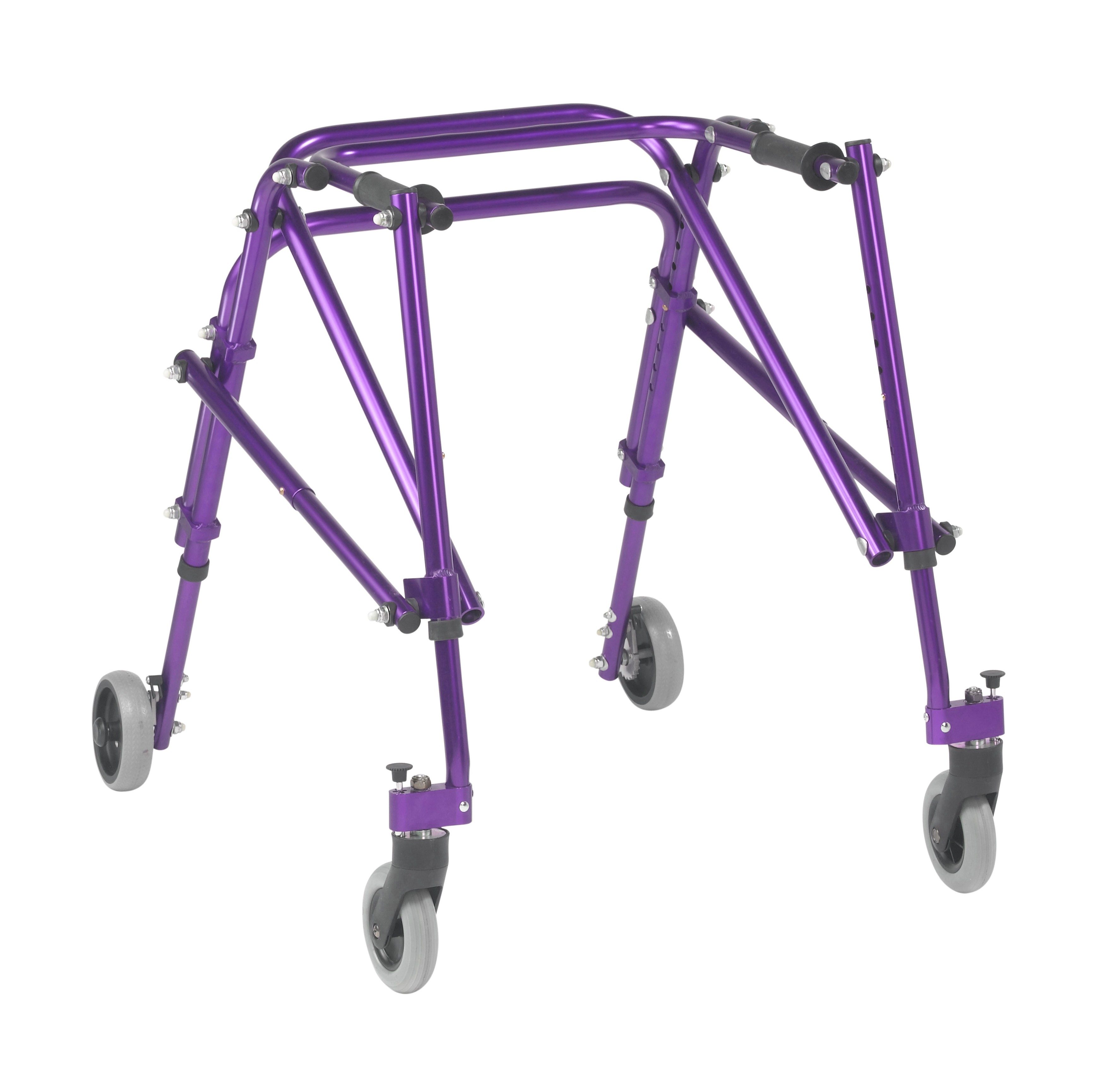
Many youth and pediatric walkers are just a smaller version of standard adult walkers that are easily adjustable to accommodate user growth. Posterior walkers, pictured above, are reverse devices commonly used by children as gait trainers to improve posture and walking skills.
Hemi Walkers
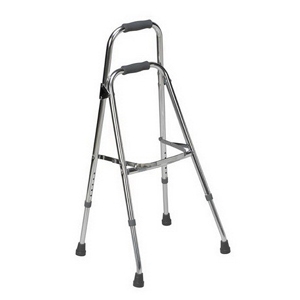
A hemi walker (or sidestepper) is a one-handed walker that combines the stability of a walker with the portability of a cane. Known as a hemi cane due to its low, hemi-height build, these walkers fold for easy transport.

Walker Sizing
Most medical walkers are height adjustable to offer ideal balance support for a full range of user heights. To ensure proper posture and avoid the risk of injury, be sure to choose a walker that is indicated for the user’s height.
The following steps should then be taken to adjust the walker to the appropriate overall height:
- 1. Have the user stand with their regular shoes on and their arms relaxed at their side.
- 2. Measure the distance between the floor and the center of their wrist – this is their wrist height.
- 3. Adjust the four legs of the walker so that the overall height (at the handgrips) matches the user’s wrist height.
Walker Specifications
When purchasing a walker for adults and petite adults (or adolescents), there are many measurements and specs to match to your needs. The following chart demonstrates the standard options available for user height, product sizing and more.
| Frame Option | Minimum Available | Maximum Available |
|---|---|---|
|
Product Weight |
5 lbs. |
12 lbs. |
|
Weight Capacity |
250 lbs. |
500 lbs. |
|
User Height |
4’6” (Junior) |
6’8” |
|
Product Height |
24.25” (Junior) |
43.25” |
|
Overall Width |
20.5” |
29” |
|
Inside Width |
16.5” |
20.5” |
|
Folded Width |
4” |
5.25” |
|
Wheel Size |
3” |
5” – 6” |
Product Weight
When purchasing mobility aids, the overall weight of the product is often an important consideration. With walkers, the only difference is that the majority of standard walkers, as shown in the chart above, are so light anyway that it is not usually a big concern.
However, if you are looking for a super lightweight walker, you may want to check out this list of our lightest walkers.
Weight Capacity
Easily the most important factor when choosing an adult walker is that the weight capacity is equal or more than the user's weight. Making sure that the walker has sufficient weight bearing capabilities to support the patient will help avoid the risk of injury during use.
User Height
When the recommended user height is listed in the product specifications, this can be an convenient way to know if the walker will be suitable to your needs. Simply confirm that the user's height falls within the listed user height range, and the walker can be easily adjusted after purchase.
Product Height
If the user height is not included, find the user's wrist height (explained earlier in the section on Walker Sizing) and make sure that the product height range of the walker you are considering includes that measurement. If the user is especially tall, you may want to consider purchasing a footpiece extension kit, which quickly and easily adds height to any walker.
Overall Width
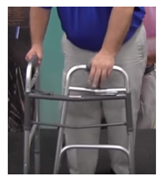 Although you might think otherwise, it is easier to find a manual wheelchair or transport wheelchair that fits through narrow doorways than it is to find a sufficiently narrow walker. While there are some walkers that are narrower than 23 inches, most walkers are 24" or wider.
Although you might think otherwise, it is easier to find a manual wheelchair or transport wheelchair that fits through narrow doorways than it is to find a sufficiently narrow walker. While there are some walkers that are narrower than 23 inches, most walkers are 24" or wider.
If this is a concern for you and you cannot find a narrow enough walker that fills your other needs, you may want to consider a two-button folding walker, which allows you to fold one side and still get some balance support as you navigate through tighter spaces.
Inside Width
Another important specification to consider is the inside width of the walker. The most common width is 17", so be sure that whichever walker you choose is wide enough to allow the user to stand comfortably within the frame.
Folded Width
If easy, convenient storage of the walker is important to you, check the folded width to ensure that it works for your needs.
Wheel Size
Depending on how smooth you want or need the roll to be, you may want to choose a larger wheel size for your walker. This is mainly a concern for those who use their walker outside on a regular basis, as we will now discuss.
Walker Folding Types
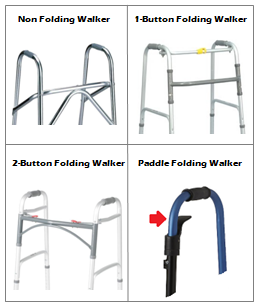 The three basic versions of folding walkers include a single-button walker, a two-button walker and a paddle walker.
The three basic versions of folding walkers include a single-button walker, a two-button walker and a paddle walker.
A single-button walker has a single point of contact to collapse both arms (sides) of the walker.
The most common walker type, the two-button walker, features two controls so that one side can be collapsed while the other side remains rigid, which provides more flexibility for seating, positioning and maneuvering through narrow or tight spaces.
A paddle walker is a higher end option of the two-button walker that allows the user to reach the folding mechanism with their index finger while their hands are still on the grips. Like the two-button walker, each arm of the paddle walker can be closed independently of the other to allow for more flexibility.

Because of their extra wide frames, bariatric walkers are generally designed as two-button folding walkers to make it possible to get through all doorways.
Walker Wheel Options
| Walker Wheel Option | Balance & Support | Smooth Roll | Benefits |
|---|---|---|---|
|
No Wheels |
High |
Poor |
Most steady |
|
Fixed Front Wheels |
Good |
Good |
Smooth, safe roll |
|
Swivel Front Wheels |
Medium |
Good |
Improved roll and maneuverability; can be locked into fixed position |
|
Rear Brakes with Wheels |
Good |
High |
Improved roll and safety for wheeled walker |
If you're in the market for a new walker, you probably know that you need to decide whether you're looking for one with or without front wheels. But there is a lot more you need to know.
For starters, keep in mind that there are many replacement leg parts for walkers, so if you change your mind or need more than one option, you can simply purchase the extra parts to switch up your walker.
Basic Wheel Options
As shown in the chart above, there are four main options: (1) walkers with no wheels, (2) walkers with two fixed wheels, (3) walkers with two swivel wheels and (4) wheeled walkers that have rear brakes with wheels (effectively giving the walker four wheels in total).
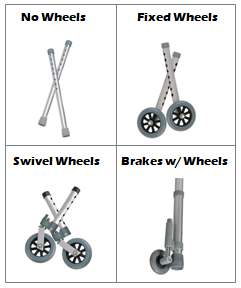 1. Walkers without wheels give the most stability and are ideal for unsteady walkers. However, there is a downside to skipping the wheels: walkers without wheels tend to get caught on uneven terrain and can be difficult to maneuver. This is mainly a concern for users who intend to use the walker outdoors.
1. Walkers without wheels give the most stability and are ideal for unsteady walkers. However, there is a downside to skipping the wheels: walkers without wheels tend to get caught on uneven terrain and can be difficult to maneuver. This is mainly a concern for users who intend to use the walker outdoors.
2. Fixed front wheels are a great option for individuals who use their walkers outdoors or on uneven surfaces but still require very steady support. These wheels are available in a range of sizes; 3" and 5" are the most common options.
3. Swivel wheels offer improved maneuverability over fixed wheels, and generally can be locked in place to function as fixed wheels at any time. Swivel wheels are not recommended for individuals with extreme mobility issues as these wheels make the walker less sturdy.
4. Rear brakes with wheels are a great addition to any walker with front wheels. The weight-activated brakes make the walker safer, while the extra wheels help the walker glide more smoothly.
Wheel Size Options
If you need a walker with wheels, you'll need to decide what size wheel you prefer. The standard size is 3" and is sufficient for most users, especially those who mainly use their walker indoors.
For individuals who tend to use their walker outside on a more regular basis, larger wheels such as the 5" option will make it easier to maneuver the walker and roll over bumps.
Note that all wheel sizes have the same width and choosing a 5" wheel over a 3" will not affect the walker's overall width.
Walker Accessories
Once you've found the walker that is ideal for you, you can personalize it by choosing from a wide variety of products that offer better functionality or helpful features.
Walker Glide Options
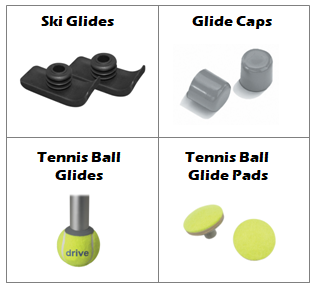 When using a medical walker without wheels or even with two wheels in the front, many patients find that the walker tends to get caught on small bumps along the way. Glides are walker accessories that can help ensure a smoother ride and reduce the risk of falls, making them one of the most important walker accessories you should consider for your walker.
When using a medical walker without wheels or even with two wheels in the front, many patients find that the walker tends to get caught on small bumps along the way. Glides are walker accessories that can help ensure a smoother ride and reduce the risk of falls, making them one of the most important walker accessories you should consider for your walker.
Adult walker glide types include ski glides, glide caps, tennis ball glides and tennis ball glide pads. If you're looking for a cute way to jazz up your walker, you can even get sneaker glides, which are comparable to ski glides in function but are designed to look like miniature sneakers.
Other Walker Accessories
Most walker accessories are products designed to make it easier to carry items from one place to another, since a walker user needs their hands free to operate their walker. Other accessories, such as wheel extensions or a platform attachment, add safety and functionality to the walker.
| Accessory Type | Use |
|---|---|
|
Storage Basket |
Visibly stores/transports larger items |
|
Basket Organizer |
Inserts into basket to contain smaller items |
|
Walker Tray |
Conveniently transports food and other items from room to room |
|
Cane/Cup Holder |
Optional attachments for holding a cane, cup or both |
|
Organizer Pouch |
For phones, computers, glasses, medication and more |
|
Extension Footpieces |
Easily adds height to walker for taller users |
|
Platform Attachment |
Cradles forearm for users who can't grip the walker |
|
Walker Light |
Hands-free flashlight which attaches without damaging frame |
Some walkers are designed with brightly-colored frames or a sleek, modern design, but the majority of walkers have a more medical look than rollators. For those who require the extra stability of a medical walker but don’t like the basic aluminum look, you may want to consider decorating your walking aid.
Walker Prices
How much does an adult walker cost? That depends on the product you choose.
Walker prices range from as low as $25 to $125, with price variations based primarily on durability, weight capacity and special features.
When comparing multiple walkers, keep in mind that different manufacturers mark up their products differently, so there are many products that are comparable in quality but still have a significant price difference. For this reason, prices are not necessarily the best indication of the quality or superiority of the walker in question.

Further Reading
More on Rollators vs. Walkers: Because rollators and walkers are very similar in function and build, it’s easy to confuse the two – but if you’re considering one of these mobility aids for purchase, it’s important to get clear on how they differ. Read these articles to learn more about the differences and how to choose the correct one for your needs.
More Mobility Aid Guides: To learn more about the other types of mobility aids available, read more at the links provided below.
Do you have something to add? There’s nothing like personal experience! Let us know by calling or emailing us, and we’ll make sure to update our information.
At AvaCare Medical, we’re here to help you find the walker that works for your needs. If you’re still confused about your options, give us a call today at 1-877-813-7799.
Disclaimer: No information presented on this website is medical advice or intended as a substitute for the advice of a physician. All information on this website concerning medical conditions is from publicly available sources.
Was this article helpful? Help others; pass it on!



